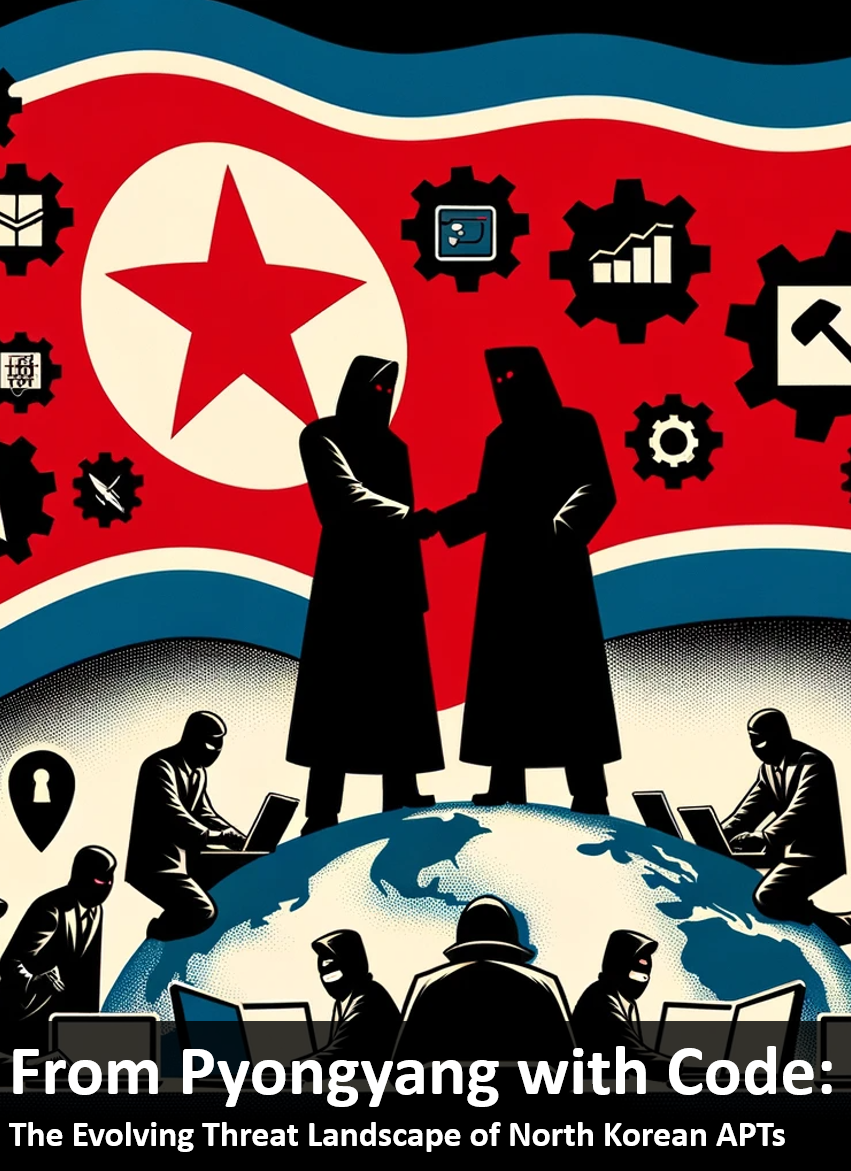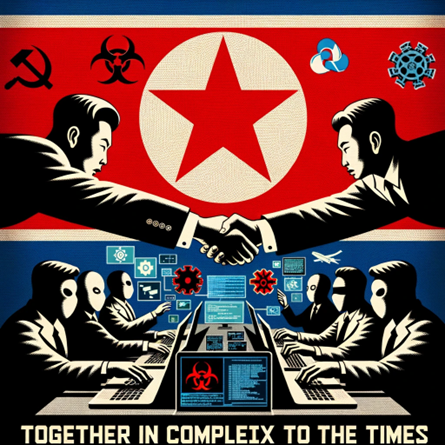From Pyongyang with Code: The Evolving Threat Landscape of North Korean APTs

North Korean Advanced Persistent Threat (APT) groups have seen unprecedented collaboration since the onset of the COVID-19 pandemic, introducing a new layer of complexity in their cyber operations. Historically distinct groups, such as the Lazarus Group and Kimsuky, increasingly share tools, information, and efforts, blurring lines of individual operations. This has resulted in diversifying attack methods, including malware tailored for different platforms and potential supply chain risks. While their operations become more complex, their primary objectives of gathering intelligence and funding the North Korean regime remain consistent. The pandemic-induced challenges, like closed borders, have inadvertently forced increased communication and coordination among these groups.
Increased Complexity - The Shifting Terrain of North Korean Cyber Threats
In the ever-evolving landscape of cyber threats, adaptability is a consistent theme. Yet, the transformative strategies North Korean (APT) groups adopted recently have added unprecedented intricacy, challenging global defensive frameworks like never before.
Historic Standalone Operations: In the past, North Korean APTs functioned as isolated units, each characterized by its set of tactics, techniques, and procedures (TTPs). Such demarcation enabled cybersecurity experts to detect, attribute, and neutralize threats based on familiar operational footprints.
Pandemic-Induced Collaborative Dynamics: The COVID-19 pandemic brought about a pivotal shift in these groups’ strategies. Spurred by the pandemic’s constraints or strategic recalibration, a pronounced trend towards inter-group collaboration emerged. This unity has birthed a generation of cyber threats that are diverse in their approach and agile in execution.
Blended Operational Tactics: The era of collaboration witnessed APTs pooling their tools, expertise, and intelligence. This convergence diluted the once-clear demarcations of their operations. Now, an attack might fuse the advanced malware capabilities of one faction with the covert penetration techniques of another, resulting in composite threats that are more challenging to foresee and neutralize.
Broadened Attack Spectrum: This era of shared resources and knowledge has empowered these APTs to cast a wider net concerning their targets. While certain groups once predominantly zeroed in on financial sectors, the collective resource pooling now enables them to launch simultaneous assaults on varied sectors, from energy and healthcare to crucial infrastructures. Moreover, crafting malware designed for diverse platforms, including Windows, Linux, and MacOS, signifies an ambition to capitalize on an expansive set of vulnerabilities.
Operational Confluence: This newfound collaborative spirit has also seen APTs’ operations overlap. It’s becoming increasingly typical to observe multiple North Korean APTs converging on a singular target, albeit through varied methodologies. Such a multi-faceted approach can be daunting for defenders, necessitating concurrently responding to various threats.
The intricate nature of the operations of North Korean APTs accentuates the imperative for fluid and forward-thinking defense strategies. As these groups persistently refine their collaborative efforts and resource-sharing, the onus is on defenders to similarly evolve, embracing a comprehensive and proactive stance on cybersecurity.
Attribution Challenges - Deciphering the Hand Behind the Cyber Sword
In the realm of cybersecurity, attribution—the act of identifying and linking a cyber attack to a specific actor or group—is of paramount importance. It informs diplomatic, legal, and military responses and deters potential adversaries. However, the evolving landscape of North Korean (APTs) has made this task increasingly labyrinthine.
Historical Clarity: Historically, the distinct modus operandi, tactics, techniques, and procedures of individual North Korean APTs provided a semblance of clarity. Each group left behind a unique digital “fingerprint,” enabling cyber experts to attribute attacks with a reasonable degree of confidence.
The Blurring of Lines: This clarity has begun to diminish with increased collaboration among North Korean APTs. Shared tools, resources, and tactics have muddied the waters. Attacks today may bear the hallmark techniques of multiple groups, making it arduous to pinpoint responsibility to a singular entity.
Shared Malware Repositories and Code: The sharing of malware codes and repositories among APTs exacerbates the attribution challenge. When multiple groups deploy the same malware strain or exploit, linking an attack to a specific group becomes a complex puzzle.
Use of False Flags: To further complicate matters, there’s the tactic of “false flags,” where threat actors deliberately imitate the TTPs of another group to mislead investigators. Given the intermingled operations of North Korean APTs, discerning genuine patterns from deliberate misdirection becomes even more challenging.
Operational Overlaps: As highlighted in the complexity section, multiple North Korean APTs may target the same entity using varied approaches. This convergence not only poses defensive challenges but also complicates attribution. Analysts must dissect each thread when faced with multifaceted attacks, discerning whether they originate from a single source or multiple collaborating entities.
Global Implications: The inability to accurately attribute cyber attacks can have significant geopolitical implications. Wrongful attribution can lead to misguided diplomatic or retaliatory actions, potentially escalating tensions.
Attribution is no longer a straightforward endeavor in the context of North Korean APTs. The intertwined operations shared resources, and deliberate obfuscations demand reevaluating traditional attribution methodologies. Cybersecurity experts must now employ a combination of technical forensics, human intelligence, and geopolitical analysis to discern the puppeteers behind the digital curtains.
Supply Chain Risks - North Korean APTs’ Expanding Attack Surface
With their vast and interconnected nature, supply chains have always been prime targets for cyber adversaries. Their multifaceted structure provides numerous infiltration points, and successful breaches can have cascading effects. North Korean APTs, recognizing this potential, have increasingly targeted supply chains, introducing a plethora of risks that need urgent attention The Allure of the Supply Chain: Supply chains, by design, involve multiple entities—manufacturers, suppliers, distributors, and customers. Each entity can have its cybersecurity practices, creating a myriad of vulnerabilities. This presents a ‘domino effect’ opportunity for threat actors: compromise one weak link, and you gain the potential to affect all others in the chain.
Historical Precedence: While supply chain attacks aren’t entirely novel, their frequency, sophistication, and scale have seen a marked increase with the collaborative evolution of North Korean APTs. Their ability to pool resources, share intelligence, and coordinate attacks makes them especially formidable adversaries in the context of supply chain threats.
Tactical Shifts: Traditionally, many cyberattacks focused on end targets—breaching a specific organization or entity. However, North Korean APTs, recognizing the leverage supply chains offer, have shifted some of their focus. By targeting software providers, third-party vendors, or even logistics partners, they can potentially gain access to a much broader set of final targets.
Real-World Implications: The ramifications of supply chain attacks can be widespread. They can lead to intellectual property theft, disruption of critical services, financial losses, and even potential physical damages if industrial control systems are involved. For businesses, this also translates to reputational damage and possible legal consequences.
Necessity of Collaboration -Countering North Korean Through Unified Efforts
In an era where threats are increasingly sophisticated and borders in the digital realm become nebulous, collaboration emerges as a potent weapon. As North Korean APTs band together, refining their tactics and pooling resources, the need for collaborative defense strategies among nations and organizations has never been more paramount.
Mimicking the Adversary: The adage “Know your enemy” is a timeless piece of wisdom. North Korean APTs have demonstrated the power of collaboration, with their combined efforts leading to more intricate, adaptable, and potent cyber threats. To counteract this, defenders must adopt a similar collaborative ethos, sharing intelligence, resources, and strategies.
Breaking Silos in Cyber Defense: Traditionally, nations, organizations, and sectors have operated in silos, guarding their cyber intelligence and defense tactics. However, in the face of a unified threat, such isolated strategies can be counterproductive. Collaboration fosters a dynamic where one entity’s detection of a novel threat or tactic can be rapidly disseminated, shielding others from potential breaches.
The Power of Collective Intelligence: When multiple entities collaborate, they pool not just resources but also intelligence. This collective intelligence—encompassing diverse data points from varied sectors, regions, and systems—creates a more comprehensive view of the threat landscape. It allows for quicker identification of patterns, faster mitigation of threats, and a proactive approach to emerging vulnerabilities.
Overcoming Geopolitical Barriers: While the digital realm offers seamless connectivity, geopolitical barriers often hinder collaboration. Trust deficits, strategic interests, and historical animosities can deter nations and organizations from sharing vital cyber intelligence. Overcoming these barriers is crucial. The shared threat of North Korean APTs offers an opportunity for entities to prioritize collective security over individual interests.

For collaboration to be effective, structured frameworks and platforms are essential. These can facilitate real-time sharing of threat intelligence, coordination of defense strategies, and joint research endeavors. Through intergovernmental alliances, industry consortiums, or public-private partnerships, such collaborative platforms can amplify the collective defense capabilities. The evolving tactics of North Korean APTs underline a pressing reality: the old paradigms of isolated cyber defense are inadequate. In a world where threat actors continually innovate and collaborate, defenders must reciprocate in kind. The necessity of collaboration isn’t just a strategic choice; it’s an imperative for global cyber resilience.
Why Would North Korea Have Multiple APT Groups?
Specialization: Each APT group can specialize in a specific type of cyber operation. Some groups might focus on intelligence gathering, others on financial theft, and yet others on creating disruptions. By specializing, each group can develop deep expertise in its area, leading to more successful operations. For instance, the Lazarus Group is known for its aggressive financial theft operations, while APT37 (or Reaper) is more focused on espionage against specific targets.
Compartmentalization: In intelligence and military operations, compartmentalization is a standard procedure. By keeping operations and groups separate, the compromise of one group doesn’t necessarily jeopardize others. If one group is detected or its methods are exposed, other groups can continue their operations unaffected.
Diversification of Tactics: Different groups can employ varied tactics, techniques, and procedures (TTPs). This diversification makes it harder for defenders to predict and counter threats. When facing multiple groups with different TTPs, defenders must spread their resources and attention, making their defense posture potentially weaker.
Geopolitical Strategy: By maintaining multiple APT groups, North Korea can pursue different geopolitical objectives simultaneously. One group might target institutions in a rival country, and another might focus on gathering intelligence from international organizations. Yet, another might focus on stealing funds to bypass economic sanctions.
Redundancy: In cyber operations, redundancy can be beneficial. If one group faces setbacks or its operations are thwarted, others can take over or ramp up their activities. This ensures continuous pressure on targets and maintains the momentum of cyber campaigns.
Deception and Misdirection: Multiple groups can engage in “false flag” operations, where they deliberately imitate the TTPs of other groups, confusing defenders and making attribution more challenging. This can lead to misdirected blame, creating geopolitical tensions elsewhere while the actual perpetrator remains obscured.
Evolution and Adaptation: The cyber realm is dynamic, with rapid technological advancements. Multiple groups allow for parallel evolution and adaptation. As one group learns and innovates, it can share its advancements with others, ensuring that the nation’s cyber capabilities are continually refined.
Having multiple APT groups provides North Korea with flexibility, a diversified approach, and a multi-pronged strategy in its cyber operations. It allows for a combination of specialization and broad coverage, ensuring that the nation can pursue its objectives effectively in the cyber domain.
The evolving landscape of North Korean (APT) groups presents new challenges in cybersecurity. These groups, once distinct in their operations, are now collaborating more than ever, increasing their effectiveness and complicating defense efforts.
Their shift towards shared resources and tactics has made attribution difficult. Furthermore, their expanded focus on supply chain vulnerabilities has broadened the potential attack surface. This change in strategy necessitates a parallel shift in defense approaches.
However, there’s an evident solution: collaboration. Just as North Korean APTs have united, global defenders must also come together. Sharing intelligence and resources could be the key to countering these collective threats. As the cyber landscape changes, so too must the strategies to defend it.

